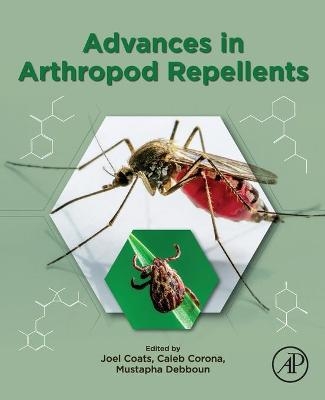
Advances in Arthropod Repellents
Academic Press Inc (Verlag)
978-0-323-85411-5 (ISBN)
This book is a valuable resource for entomologists and vector control researchers and practitioners. Public health officials and developers in private pest control companies, as well as readers in academia will find this a useful resource to learn the latest information available on controlling the spread of arthropod-borne diseases with repellents.
Joel Coats, Charles F. Curtiss Distinguished Professor of Entomology, in the Department of Entomology at Iowa State University, received his academic training at the University of Illinois at Urbana-Champaign, later obtaining a M.S. and Ph.D. in Entomology, with specialization in insecticide toxicology and environmental toxicology. His research program focuses on insect toxicology and environmental toxicology and chemistry. Current studies are focused on natural products as insecticides and repellents, as well as biorational analogs of them. Dr. Coats received the International Award for Research in Agrochemicals from the American Chemical Society; he is a Fellow of the American Association for the Advancement of Science, Fellow of the American Chemical Society, and a Fellow of the Entomological Society of America. He has trained 53 graduate students and published over 200 peer-reviewed publications, including 15 books. Caleb Corona received his Ph.D. degree in Entomology and Toxicology from the lab of Dr. Joel Coats, Iowa State University, where his research focused on the development of novel insecticides and spatial repellents derived from natural products. He received his B.Sc. degree in Biology with a Chemistry minor from King University in Bristol, Tennessee, where he also served as a Teaching Assistant in Chemistry and later an undergraduate research assistant for federally funded Toxicology laboratory under Dr. Vanessa Fitsanakis . He has been invited as a symposium speaker at the Society for Vector Ecology, the Entomological Society of America, and the American Chemical society multiple times over the course of his career. Mustapha Debboun has a Ph.D. in Medical and Veterinary Entomology from the University of Missouri-Columbia, is a Board-Certified Entomologist (BCE) with the Entomological Society of America (ESA) and confirmed with the title of Fellow of the ESA. He has more than 27 years of experience in public health entomology, integrated vector management, personal protective measures, and mosquito/vector-borne diseases where this work has taken him to over 35 countries in Africa, Asia, Australia, Europe, and South America. He is currently the General Manager of Mosquito & Vector Control District in Visalia, California. He has published over 120 peer-reviewed scientific articles and co-edited five books. Dr. Debboun organizes national and international symposia, serves on 10 journal editorial review boards, and a reviewer for eight scientific peer-reviewed journals. He is also nationally and internationally recognized for his extensive work on arthropod repellent research and development.
Part One: Novel Arthropod Repellent Molecule Discovery or Assay Development 1. Introduction: The Role of Arthropod Repellents in Public Health 2. Novel Pyrethroid Derivatives as Effective Mosquito Repellents and Repellent Synergists 3. Biorational Compounds as Effective Arthropod Repellents Against Mosquitoes and Ticks 4. Evaluating Techniques and Efficacy of Arthropod Repellents Against Ticks 5. Evaluation and Application of Arthropod Repellent Treated Uniform/Clothing and Textiles Against Vectors 6. Repelling Mosquitoes with Electric Fields
Part Two: Mechanism of Arthropod Repellent Research and Development 7. Multimodal Mechanisms of Repellency in Arthropods 8. Finding a Repellent Against Ticks: Neurophysiological and Behavioral Approaches 9. Arthropod Repellents and Chemosensory Reception
Part Three: Conducting Arthropod Repellent Studies in Field and Semi-field Trials 10. Semi-field Bioassays for the Evaluation of Spatial (and Topical) Arthropod Repellents for Indoor and Outdoor Use 11. Semi-field Evaluation of Arthropod Repellents: Emphasis on Spatial Repellents 12. Human Subject Studies of Arthropod Repellent Efficacy 13. Arthropod Repellent Research in Northwest Florida
Part Four: The Current Status and Future Uses of Arthropod Repellents 14. The Current Status of Spatial Repellents in the Global Vector Control Community 15. Repellent Semiochemical Solutions to Mitigate the Impacts of Global Climate Change on Arthropod Pests 16. The Role of Arthropod Repellents in the Control of Vector-Borne Diseases
| Erscheinungsdatum | 22.10.2021 |
|---|---|
| Verlagsort | Oxford |
| Sprache | englisch |
| Maße | 191 x 235 mm |
| Gewicht | 700 g |
| Themenwelt | Naturwissenschaften ► Biologie ► Biochemie |
| Naturwissenschaften ► Biologie ► Zoologie | |
| ISBN-10 | 0-323-85411-7 / 0323854117 |
| ISBN-13 | 978-0-323-85411-5 / 9780323854115 |
| Zustand | Neuware |
| Haben Sie eine Frage zum Produkt? |
aus dem Bereich


